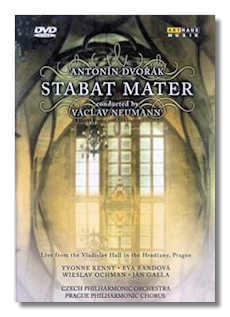
The Internet's Premier Classical Music Source
Related Links
- Dvořák Reviews
- Latest Reviews
- More Reviews
-
By Composer
-
Collections
DVD & Blu-ray
Books
Concert Reviews
Articles/Interviews
Software
Audio
Search Amazon
Recommended Links
Site News
 DVD Review
DVD Review
Antonín Dvořák

Stabat Mater
- Yvonne Kenny (soprano)
- Eva Randová (mezzo-soprano)
- Wieslav Ochman (tenor)
- Ján Galla (bass)
Prague Philharmonic Chorus
Czech Philharmonic Orchestra/Václav Neumann
Arthaus Musik DVD 102109 87:00 LPCM Stereo Full Screen
For Dvořák, international fame didn't come until he was in his 40s, and then it came partly on the basis of a work that was extremely personal to him: this Stabat Mater. He began composing it in 1875, shortly after the death of his first daughter, but then put it aside. Within the next two years, Dvořák lost two more children, and no doubt those terrible experiences spurred him forward to complete this work – an extended meditation on the death of Christ from the viewpoint of his mother.
Many composers – including Pergolesi, Rossini, Poulenc, and Penderecki – have set this text, which dates from the 1400s. Dvořák's setting is one of the most ambitious, however. It is about 90 minutes long, and requires four vocal soloists of operatic quality, full chorus, and orchestra. Dvořák's response to the text is impassioned; listeners are transported to the foot of the cross, as it were, to feel the pain of losing a child, except the pain is given almost cosmic proportions.
English audiences in particular responded powerfully to the work's pathos and pained exaltation, and the London première in 1883 set the stage for Dvořák's repeated visits to England to conduct his works. With the Stabat Mater, he had arrived.
In the past few decades, the work seems to have gone out of fashion, but it is making a comeback in recent years, as several important conductors (including Robert Shaw and Giuseppe Sinopoli – shortly before their deaths, strangely enough) have taken it up and recorded it.
Václav Neumann was principal conductor of the Czech Philharmonic between 1968 and 1990. This performance of Dvořák's Stabat Mater dates from 1989, and was filmed in the Vladislav Hall of Prague Castle. This is a wide-open, church-like interior, and although the recording controls the reverberation, the sound on this DVD is less than ideal: it is constricted and dull. The dynamic range is narrow, and high frequencies are attenuated. Most DVDs give more sonic enjoyment. In terms of camera-work, the focus is on the conductor, the soloists, and certain parts of the orchestra. (The timpani player seems to have been someone's favorite.) We rarely get a good look at the choir, leading me to be believe that there was an accessibility issue with the cameras. The booklet indicates that this event was live, yet we never see an audience, and we hear no applause at the beginning or the end. Curious.
Overall, the performance is a good one. Neumann conducts with a measure of emotional restraint, which is not a bad thing in this work. (In the wrong hands, it can become too sentimental.) His reading is nobly phrased, and the music is shaped firmly. The orchestra plays well, and the Prague Philharmonic Chorus does excellent work. Yvonne Kenny is radiant in her solos, and Eva Randová is not far behind. The flies in the ointment are the contributions of Ochman and Galla. The former sounds dry and pinched, and the latter is wobbly and woofy, making the fifth movement something of a trial. When they are singing together, the blend among the soloists is rough. (They should have listened to the chorus more, because they get it right.)
This appears to be the only representation of Dvořák's Stabat Mater on CD. It's a mixed bag. It will do for now, but let's hope it gets some competition soon.
Copyright © 2008, Raymond Tuttle




















